1860 – Karl Friedrich Ferdinand Schnake
Karl (later Carl or Charles) Friedrich Ferdinand Schnake was born on May 17, 1860 in house #73 in the tiny hamlet of Tengern, in Kreis Lübbecke (the county of Lübbecke), in Provinz Westfalen (the Province of Westphalia), a part of Königreich Prueßen (the Kingdom of Prussia).
Karl was baptized on March 20, 1860 at the Evangelische Kirche Schnathorst in the nearby village of Schnathorst, which was large enough to support a church and pastor. Tengern is located just south of the towns of Holsen, Schnathorst and Hüllhorst in Westfalen where my Struckmeier ancestors originated.
Karl’s parents were Karl Friedrich Ferdinand (Ferdinand) Schnake (1827-1883) and Anne Marie Louise (Louise) Kottmeier (1833-1910). He was the second of three children. The first, Karl Christian Ludwig Schnake, died five days after his birth. Karl Friedrich Ferdinand Schnake arrived two years later.
A 1924 obituary stated that Karl Schnake was born in the “so-called Ravensberg Land” (or “Ravensbergerland” in the Eden Seminary archives). This refers to a region that took its name from the historic Grafschaft Ravensberg (County of Ravensberg), which was a part of the Heiligen Römischen Reiches (Holy Roman Empire) in eastern Westfalen from about 1200 to 1614. While I don’t believe that Tengern was actually a part of that historic county, nonetheless the name Ravensberg Land was broadly applied to the area. I do know that Bielefeld, the town about 20 miles away where Karl Schnake later went to study for the diaconate, was within the historic Grafschaft Ravensberg.
early education and work
From ages 14 to 20, Karl was a student in Prussian normal schools. At this time, Prussia considered education important, and provided free public education even for the children of peasants and farmers.
Karl later described his early years:
“I was born on 17 May 1860 in Tengern, Kreis Lubbeck, Wetsphalia. During my confirmation ceremony, I had one passionate longing, to be an evangelical preacher. Pastor Weihe recommended me to Pastor F. v. Bodeschwingh in Bielefeld, to become a pastor to the Germans in America. With joy I was accepted into the “Brotherhood Nazareth” in Bielefeld. Here I started with my studies for the service in the “innere Mission” [Inner mission means pastoral care within Germany]. Here began my preparation for service in the American mission. In 1884 I was sent to Harlem, Holland, to take position ministering to epileptics. In this work God gave blessings and success, and the opportunity came to me to become a housefather, but the wish to become a pastor in America was so strong that I did not accept. In the summer of 1886 I was sent to America to continue my studies at the Theological Seminary near St. Louis.
Brüderhaus Nazareth in Bielefeld
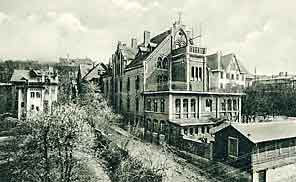
Beginning in 1880, Karl spent four years as a student for the diaconate at the Brüderhaus Nazareth in Bielefeld, Westfalen, Prueßen. Bielefeld is an industrialized town less than 20 miles south of the farming villages of Tengern, Schnathorst, and Hüllhorst.
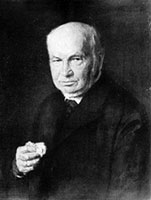
Pastor Friedrich von Bodelschwingh had founded the Brüderhaus Nazareth school for deacons in 1877 as part of a larger complex, the Bethel-Institut für Epileptiker und Idioten (Bethel Institute for Epileptics and Idiots) at Bielefeld, which had been founded by the Prussian Evangelical church in 1867.
In 1900, author William Pryor Letchworth described the Bethel Institute in his book Care and Treatment of Epileptics, (G. P. Putnam’s Sons, New York and London, Knickerbocker Press):
The institution, established by the Provincial Committee of the Inner Mission in Rhineland and Westphalia, is situated on the outskirts of Bielefeld, a city in the province of Westphalia, Germany, having about fifty thousand inhabitants. On the 1st of July, 1898, the settlement contained, with its officers, physicians, nurses, and employees, about 3,500 persons. The colony, lying mainly in a pleasant valley, embraces a great variety of residences surrounded by gardens and hedges, shops for artisans of various trades, places of worship, meadowlands, and groves.
The Bethel Colony is an evangelical, charitable institution, differing in its management and development from any other establishment. The work was begun upon a small farm in 1867. The simple exercises connected with the opening of the farmhouse included the offering of prayer by the venerable pastor, who knelt in the parlor with four patients and asked God’s blessing upon the undertaking.
In 1872, Friedrich von Bodelschwingh [1831-1910], a Protestant clergyman, ignoring the prestige of an aristocratic title, gave up court life and the companionship of the German nobility, to devote his life to the building up of this hospital and home for neglected epileptics. When he assumed his duties there were twenty-four male patients at Ebenezer, as the farmhouse was called where the work was formally begun. A large building, planned to accommodate two hundred patients, was in process of erection. This was afterwards completed, although disapproved of by Pastor von Bodelschwingh as not in accord with a true colony plan. He wisely desired that the patients should be distributed in small family groups, and this policy was adopted in the future development of the institution. The large building was called Bethel, a name gradually applied to the whole colony.
To the small original farm have been added from time to time tracts of land varying in size until the estate now comprises about three thousand acres. As opportunity offered, other benevolent work was undertaken, which has proved far-reaching and beneficent in its results. This includes, among other enterprises, saving efforts in behalf of children, not only such as are epileptic, but the homeless and the enfeebled and the crippled, the establishment of the Workman’s Home, and the branch labor colonies of Wilhelmsdorf and Freistatt. The most important work of this broad charity, however, is now, as it was at the outset, the care of epileptics, who numbered 1,516, including children, on the 1st of July, 1898.
A Colony of Mercy
In 1892, author Julie Sutter visited Bethel Colony and was very impressed with what she saw. In 1893, she published a book about its history and operations called A Colony of Mercy: or, Social Christianity at Work. The New York Times reviewed the book on January 1, 1894 in an article entitled “Helped to Help Themselves.”
The home for epileptics which is called Bethel, has given its name to and become the center of a colony now divided into five distinct branches: First, Bethel proper, consisting of homes for epileptics; second, Sarepta, the Westphalian mother house for the training of deaconesses; third, Nazareth, the Westphalian brotherhood, or training house for deacons; fourth, Wilhelmsdorf, the labor colony, formed to grapple with social distress, and fifth, the Association Workman’s Home, the extremely awkward title of a scheme for providing homes of their own for the laboring classes.
The colony, which began life in the one-room farmhouse dedicated to the service of a few miserably diseased beings, now comprises about 150 houses, covering some 400 acres of ground. The main divisions mentioned and many sub-divisions are directed by “house fathers” and “house mothers” and trained assistants, unpaid, as we have said, so far as money goes, and chosen by Pastor von Bodelschwingh from among those offering themselves for the places, most of them being drawn from the sturdy and warm-hearted Westphalian people, who have had the opportunity for twenty-five years of knowing and watching the expanding influence of the work. These people have their material needs supplied, of course, in the community, and receive a certain amount of money for clothing, but of treasure to lay up on earth, they have none.
In that portion of the colony known as Bethel proper, the home for epileptics, these unfortunate invalids are provided for in the most charitable way; that is, it is made possible for them largely to provide for themselves as they could never do in the outer world from which they come. Such as can afford it pay for the privilege of being in the colony, but those who cannot pay are accepted with equal readiness. They are separated into congenial groups “parted according to sex, according to the stage of their illness, according to occupation”; and these groups are provided with work suited to their strength and their capacity. Almost every trade is represented, we are told. There are saddlers, tailors, basket makers, bookbinders, gardeners, and even by the imbeciles simple tasks are performed. The earnings of these terribly afflicted laborers all go toward the support of the colony, which is largely helped by voluntary contributions from the surrounding country promoting its enlargement, but not one cent, we understand, goes in payment of service rendered.
An 1895 biographical sketch suggests that while Karl Schnake was a student at the Brüderhaus Nazareth, he also taught at the Bethel Colony.
de Christelijke Huis in Haarlem, Kingdom of the Netherlands
In 1884, after four years of studying for “Inner Mission” work, Karl was offered a position as a deacon at a home for epileptics in the city of Haarlem in the Kingdom of the Netherlands.
Author William Pryor Letchworth also described this Dutch facility in his 1900 publication Care and Treatment of Epileptics:
At Haarlem, in Holland, a work for epileptics is carried on in what is called the Christian Home, under the direction of deaconesses. Seventy women are provided for in two buildings called Sarepta and Bethesda, the garden and grounds of which are enclosed by a wall. Under the same board of management are three houses in the country containing about seventy-five male patients, who are cared for by deacons. The institution receives but few except private patients. These are divided into four classes, paying from $120 to $500 yearly. Children are admitted at lower rates. The receipts of the Home fall considerably short of its expenditures. The deficits are met by voluntary contributions.
After about six months in Haarlem, Karl was asked to become a Hausvater (house father) but he decided not to accept in order to pursue a ministry in foreign missions. About two years after he arrived in Holland, he departed for the United States to pursue a theological education there.
emigration
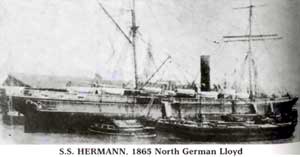
Karl Friedrich Ferdinand Schnake arrived in New York City from Bremen, Germany aboard the S. S. Hermann on July 7, 1886.
theological education
From 1886 to 1889, Karl finished his theological education at Eden Seminary in Wellston, Missouri, located just outside of the city of St. Louis.
Die Deutsche Evangelische Synode von Nord-Amerika
At the time, Eden Theological Seminary trained pastors for Die Deutsche Evangelische Synode von Nord-Amerika (the German Evangelical Synod of North America) formed from a merger of several German Evangelical synods in the United States in 1872. The Synod had its roots in a pastors’ association formed in 1840 at Gravois Settlement (now Mehlville, Missouri) and just ten years later they established a seminary, the Evangelischen Predigerseminar (Evangelical Preacher’s Seminary) near the town of Marthasville in Warren County. By 1866, this German Evangelical pastor’s association grew to become Die Deutsche Evangelishe Synode des Westens (the German Evangelical Synod of the West).
The various German Evangelical church bodies in North America traced their roots to Die Evangelische Kirche der Preußischen Union (the Evangelical Church of the Prussian Union) in Germany. It grew out of an early nineteenth century union between Lutheran and Reformed (Calvinistic) churches. In 1817, the Prussian king, Friedrich Wilhelm III, wanted a unified Protestant church and he issued a “Call to Union” to the two Protestant churches founded by Luther and Calvin. Part of his motivation was his grief that he had been unable to receive communion with his late wife because she was Lutheran and he was Reformed. In 1817, the Lutheran and Reformed traditions were united into one state church—Die Evangelische Kirche der Preußischen Union. Later, this church was called Die Evangelische Kirche der Altpreußischen Union (the Evangelical Church of the Old Prussian Union).
The name “evangelical,” which simply means “of the gospel,” was a political compromise between the two theological traditions. In the nineteenth century, the term “Evangelical” indicated a blending of Lutheran and Reformed traditions. In the United States however, the Evangelical churches were predominantly Lutheran in practice and custom.
Eden Seminary in Wellston, Missouri
When Karl Schnake attended, Eden Seminary was located on the western outskirts of Saint Louis in the town of Wellston. It was originally known as the Evangelischen Predigerseminar (Evangelical Preacher’s Seminary), the school that had been established by the preacher’s association in the summer of 1850 in a rural valley four miles east of Marthasville, Missouri. The location was isolated, and in October 1883, the seminary moved to Wellston, where the students had better access to transportation, libraries, and many German Evangelical churches. (In 1924, another relocation brought the seminary to its present location in Webster Groves, Missouri.)
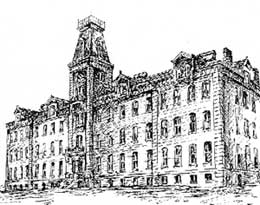
In 1886, the new College und der Theologischen Seminar der Deutschen Evangelischen Synode (College and Theological Seminary of the German Evangelical Synod) was situated on 19 acres fronting on St. Charles Rock Road at the intersection of Lucas and Hunt Road. Eden Station, a stop on the Wabash, St. Louis, and Pacific Railroad was nearby. A streetcar could travel from the Eden Station to downtown St. Louis in 30 minutes. The students spoke of making the trip to Eden, and the name began to apply to their school which was soon known as “the seminary at Eden.”
Eden was an ironic name for a place so rugged and austere. The men followed a rigid schedule of lectures, dictation, and manual labor. They were only allowed to leave the seminary on Saturday afternoons, and they were forbidden to go to the theater or a saloon or to have anything to do with women. All classes were in German. There was a gradual relaxation and modernization over the years. English was introduced in the 1890’s and students were allowed to become engaged in 1900. Karl Schnake missed those later reforms.
ordination at Die Deutsche Evangelische St. Pauls Gemeinde
He graduated from Eden Seminary and was ordained on June 23, 1889 at Die Deutsche Evangelische St. Pauls Gemeinde, (St. Paul’s Evangelical Church) at 1808 South Ninth Street near Soulard Street in the Soulard neighborhood of South St. Louis, Missouri. Today, the congregation is St. Paul United Church of Christ, 3510 Giles Avenue, St. Louis, MO 63116 (314-772-4772) (Rev. Tom Ressler, stpauluccsec@att.net)
Four decades earlier, when the Rev. Adolph Baltzer, an Evangelical pietist, resigned as pastor of St. Marcus Church over issues of church discipline, he and his supporters founded St. Paul Church on October 23, 1848. Worship services were first held in the pastor’s house at 9th Street, south of Soulard on December 31, 1848. A new church, dedicated on the same site on February 17, 1850, included the parochial school and living quarters for the pastor and school teacher. A larger church was dedicated on the same site on Novemberr 8, 1874 and expanded again in 1875. Rev. Jacob Irion was pastor of St. Paul’s from 1882 to 1922.
first parish
Carl Schnake’s first German-speaking parish was at Femme Osage in St. Charles County, Missouri where he served from 1889 to 1895.
The Eden Seminary archives don’t list a name for this congregation. The Augusta Evangelical Church was founded in 1833 and may be a possibility for the parish he served. Today, it is Augusta Femme Osage UCC, 4360 Cappeln Osage Road, Augusta, MO 63332-1118 (636-228-4586) (Rev. Bruce Alan Moeller – revbrumoe@hotmail.com). At the time, it may have been called Die Deutsche Evangelische Augusta Gemeinde.
marriage and children
On October 24, 1889, the Rev. Karl Friedrich Ferdinand Schnake married Anna Catherine Louise Charlotte Struckmeier. (Although her family called her Catherine, a biographical sketch published in 1885 referred to her as “Annie” and it appears that Anna was her preferred name during her adult life.)
1865 – Anna Catherine Louise Charlotte Struckmeier
Anna Catherine Louise Charlotte Struckmeier was born on February 21, 1865 at house #27 in the village of Hüllhorst, Kreise Lübbecke, Provinz Westfalen, Königreich Prueßen, not far from the tiny hamlet of Tengern. Anna was the seventh of nine children born to Karl Struckmeier and Anna Greimann. All four daughters were named Anna, so most went by a middle name. While growing up, Anna Catherine Louise Charlotte was known in her family as Charlotte, but after her marriage she was sometimes known as Catherine, but usually as Anna or Annie.
Anton Karl Friedrich Struckmeier, who was known as Karl, was born on November 17, 1822 in house #16 in the village of Holsen. Anna Katherina Louise Charlotte Greimann was born on November 9, 1826 in house #27 in the neighboring village of Hüllhorst. They married on February 3, 1850 and had ten children, all born at #27 Hüllhorst. They emigrated from Germany on August 29, 1872 and arrived in New York on September 21st. They settled in the small farming town of Hoyleton on the southern Illinois prairie about twelve miles southwest of Centralia in Washington County.
How Carl Schnake and Anna Struckmeier met is unknown. However, Schnake families from Schnathorst in Westfalen had settled in the town as early as the 1860s. Family members had farms in several towns in Washington Township, including Hoyleton, New Minden, North Prairie, and Nashville. Most likely, Carl may have traveled from Wellston, Missouri to Hoyleton, Illinois to visit relatives and while there met Anna Struckmeyer who attended Die Deutsche Evangelische Zions Gemeinde, or the Zion German Evangelical Congregation in that town.
children
Anna Struckmeier and Karl Schnake had eight children who were born in Missouri and Illinois over the next 21 years:
- Paul Carl Schnake, born August 16, 1890 in Femme Osage, St. Charles, Missouri
- Hedwig Schnake, born in September 1892 in Missouri (most likely in Femme Osage, St. Charles County)
- Hulda Marie Schnake, born June 14, 1894 in Missouri (most likely in Marthasville, Warren County)
- Armin Carl Otto Schnake, born April 2, 1896 (most likely in Hoyleton, Washington, Illinois). He died on July 5, 1896 at age 3 months and was buried in Hoyleton Zion Cemetery.
- Olga Charlotte Schnake, born August 9, 1897 in Hoyleton, Washington, Illinois. She died on November 17, 1897 at age 3 months and was buried in Hoyleton Zion Cemetery.
- Emil Heinrich Christian Schnake, born February 26, 1899 in Johannisburg Township, Washington, Illinois
- Alfred Schnake, born in 1901 in Missouri (most likely in Boeuf Creek, Franklin County)
- Reinhardt Schnake, born in 1910 in Missouri (most likely in Chesterfield, Saint Louis County)
Emmaus Asyl für Epileptiker und Idioten
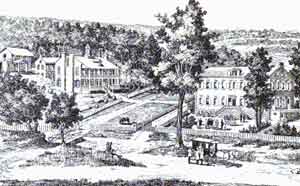
Just about seven miles west of Femme Osage is the town of Marthasville in Warren County. Four miles east of Marthasville, and three miles west of Femme Osage, was the site of the former Evangelischen Predigerseminar (Evangelical Preacher’s Seminary). The buildings had been vacated in October 1883 when the school, now known as Eden Seminary, moved to its new location in Wellston, Missouri. A group of pastors and lay people from the surrounding German Evangelical churches sought ways to use the facilities for a good purpose. Rev. Carl Schnake was one of those people. Based on his experiences in Germany and Holland with compassionate homes for people with epilepsy, he recommended the establishment of a facility on the old seminary grounds.
In 1892, the Deutsche Evangelische Synode von Nord-Amerika (German Evangelical Synod of North America) voted to set aside its former seminary property as a home for epileptics to be called the Emmaus Asyl für Epileptiker und Idioten (Emmaus Asylum for Epileptics and Idiots) for persons with mental retardation and epilepsy. Pastor Carl Schnake became the first superintendent of the home when it opened on July 4, 1893. The first resident arrived on July 5th, coming from New Orleans. Emmaus was the first institution of its kind west of the Mississippi.
In the 1900 book by William Pryor Letchworth entitled Care and Treatment of Epileptics, the author describes the Emmaus Asylum near Marthasville, Missouri:
The charity was organized by Rev. C. Schnake. Two buildings of stone, spacious, well lighted, and well ventilated, afford accommodations for fifty patients, and, together with the residence of the Superintendent and a small chapel, comprise the buildings of the colony. The estate contains 240 acres, the greater part of which has not been cleared and fitted for field use.
The Emmaus Asylum for Epileptics and Idiots was also known as the Emmaus Asylum for Epileptics and Feeble-Minded, and later was called the Emmaus Home for Epileptics and the Mentally Retarded. Today, Emmaus Homes is a ministry of the United Church of Christ and continues to serve developmentally disabled people in a number of locations in the St. Charles, Missouri area.
In a history of Emmaus Homes on their web site, they state:
At the turn of the century, the public response to the needs of people with developmental disabilities was to place them in facilities where special care could be provided. Emmaus Homes provided residential services, as well as a full array of maintenance services, reflective of the times and its Christian foundations. During its early years of existence, Emmaus Homes used its farms as a source of livelihood. Those persons capable of contributing to their own care assisted in duties of the farming and dairy operation, caring for livestock, harvesting grain or stacking hay. Women helped in the laundry, gardens, and kitchen. They developed functional skills relevant to their life situations at that time.
Churches affirmed Emmaus Homes as an important mission and contributed to its operating costs with offerings of money, food and material items. Compelled by their faith, they desired that a community of love, understanding and caring be cultivated and shared among those living at Emmaus.
Apparently, while serving as superintendent of Emmaus, Carl Schnake also continued to serve as pastor of the church in Femme Osage.
1895 biographical sketch
The following is an excerpt from a book published in 1895—Portrait and Biographical Record of St. Charles, Lincoln and Warren Counties, Missouri: Containing Portraits and Biographical Sketches of Prominent and Representative Citizens of the Counties (Chicago: Chapman Publishing House, 1895, pp. 354-355)
Rev. C. Schnake, the Superintendent of Emmaus Asylum for Epileptics and Idiots, which institution is situated near Marthasville, Warren County, has had a wide experience, both in Germany and in the United States, with this unfortunate class of people, and with insanity in its various stages. He is a young man, and brings to bear upon his work not only extended knowledge and study, which have extended over a number of years, but also a kind heart and well founded Christian principles.
The parents of Rev. Mr. Schnake, Ferdinand and Louisa (Kollmeyer) Schnake, were born and reared in Germany. The former has been called to the better land, but his wife is still living [in 1895] at her old home in Germany. The birth of our subject occurred in the year 1860, and his early education was obtained in the schools of the Fatherland which he attended until he was fourteen years of age. For the next ten years of his life he was a student in the normal schools, and at the end of this period he obtained a position as teacher in the Bethel Institute for Epileptics and Idiots at Bielefeld. This is a very large institution, of national renown, and was founded in 1867. For four years our subject’s time was employed in this institute, after which he was induced to accept a position at Haarlem, Holland, where the citizens had established a similar institution. He was subsequently chosen as one of the managers, and served in that capacity for about a year and a-half.
In 1886, Rev. Mr. Schnake came to the United States, and entered Ethen [Eden] College, at St. Louis, Mo., where he spent three years in theological study. His first charge was at Femme Osage, St. Charles County, whither he went in 1889. In 1892, the institute with which he is now connected was established by private subscription and enterprise. Mr. Schnake was called to undertake the superintendency of the asylum, which completed its first year’s record in July, 1894. The enterprise has thus far been very successful, and is attracting more than local fame.
In October, 1889, the marriage of Rev. Mr. Schnake and Annie Struckmeyer occurred. The lady is a native of Germany, but came to live in the United States when she was a mere child. Her parents, Charles and Catherine (Greimann) Struckmeyer, were also born in the Fatherland, but for a number of years were residents of Hoyleton, Ill. To our subject and wife have been born three children: Paul, Hedwig, and Hulda.
Though very conservative on the question of politics, our subject generally votes the Republican ticket. His position in the Emmaus Asylum is one of great difficulty and responsibility, and one which few men would care to undertake. His Old World experience, however, stands him in good stead, and with judgment and discretion usually attained by men of twice his years, he is meeting every requirement of the place.
additional Missouri parishes
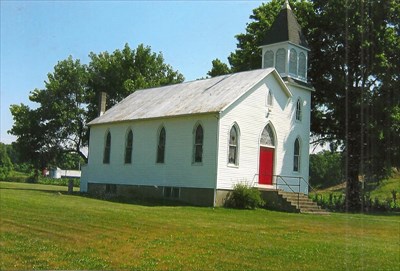
From 1896 to 1897, Carl Schnake was pastor of Die Deutsche Evangelische St. Marcus Gemeinde, or Saint Marcus Evangelical Church, in Rhineland, Montgomery, Missouri. The congregation no longer exists in this building. Located on the north bank of the Missouri River, Rhineland was devastated by water in the Great Flood of 1993. The building was damaged some, and the devastation of the flood so great, the congregation actually moved from this church to a new one in Hermann, Missouri. Rhineland became the first town to accept federal funds to move out of a flood plain. All the houses in the town were moved about 1½ miles uphill. The church was restored in 1994 by the farmer who bought the land on which it stands. He thought it was important enough, and so chose to keep it as best he could.
In 1897, Carl Schnake was pastor at nearby Die Deutsche Evangelische St. Johannes Gemeinde, or Saint John Evangelical Church, in High Hill, Montgomery, Missouri, founded in 1887. Today, it is High Hill St. John’s United Church of Christ, 202 Spruce Street, High Hill, MO 63350-1201 (Donald L. Deeker, pastor – stjohnsucc@1pcplace.com).
A handwritten entry in the Eden archive records and his obituary both show that Pastor Schnake also served at a congregation in Drake, Gasconade, Missouri sometime between his service at Femme Osage and his first Illinois parish at Stone Church. No specific date or congregation is given. This church probably did not survive. There are no United Church of Christ congregations in the area today.
Illinois parishes
By 1897, Rev. Carl Schnake had moved his family to Washington County, Illinois near the town of Hoyleton where Anna’s family had settled in 1872 and some members of the Schnake family from Schnathorst had also settled.
From 1897 (perhaps as early as 1896) to 1899, Carl Schnake served as pastor at Die Deutsche Evangelische St. Peter Gemeinde, or Saint Peter Evangelical Church, in Stone Church, Washington, Illinois. Stone Church is about 18 miles west of Hoyleton.
Anna gave birth to their son Armin (April 2, 1896) in Hoyleton and their daughter Olga Charlotte (August 9, 1897) was born there as well. Both children died in infancy at about the age of three months, and both are buried in the Hoyleton Zion Cemetery.
Carl and Anna Schnake remained in Illinois until 1900. That year’s census lists them in Johannesburg [Johannisburg] Township, Washington, Illinois. Johannisburg is about two miles north of Stone Church.
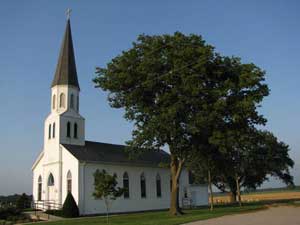
From about 1899 to 1900, Carl served at Die Deutsche Evangelische St. Johannes Gemeinde, or Saint John Evangelical Church, which was founded in Johannisburg in 1837.
Today, the church is St. John’s UCC, 11360 Main Street, Johannisburg, IL 62214-1420 (618-824-6298) (Rev. William E Groennert, pastor – blg@htc.net).
It is possible that Carl served the two neighboring congregations concurrently just before the turn of the century.
Anna gave birth to their son Emil Heinrich Christian on February 26, 1899. He was baptized at St. John’s church in Johannisburg on March 22, 1899. His middle names came from his baptismal sponsors Heinrich Struckmeier and Christian Koelling. Heinrich (also known as Henry or Hy) was Anna’s older brother and Christ Koelling was married to Anna’s sister Louise.
parishes in Missouri and Illinois
From 1900 to 1903, Carl Schnake served at Die Deutsche Evangelische Ebenezer Gemeinde, or Ebenezer Evangelical Church, in Boeuf Creek, Franklin, Missouri. Boeuf Creek is a stream that flows through Franklin county, but apparently a town by that name no longer exists. There is a Boeuf Township, near the town of New Haven in Franklin county. But the UCC church in New Haven is Saint Peter’s, not Ebenezer.
Wherever this town and congregation was, this must have been where the Schnake’s son Alfred was born in 1901.
In 1903, Carl Schnake went to Die Deutsche Evangelische Bellefontaine Gemeinde (the German Evangelical Bellefontaine Church) founded in 1892 to serve the small farming community of Chesterfield, Missouri. It later became Saint John Evangelical Church in Chesterfield, Saint Louis, Missouri. The Eden archives show that he was there until 1912. Today, this congregation is St. John’s United Church of Christ, 15370 Olive Boulevard, Chesterfield, MO 63017, (636-532-0540), stjohnsucconolive@gmail.com. (Rev. Lisa Hart, interim).
Another archive entry shows that Carl served there again from 1908 to 1913. To add to the confusion, during this period they also have him serving at Zion Evangelical Church in Central City, Marion, Illinois from 1907 to 1909.
Based on this information, the likely scenario is that Carl Schnake served at Saint John in Chesterfield, Missouri from 1903 to about 1907. Then he went back to Illinois to serve at Zion in Central City until 1909, and finally returned to Saint John in Chesterfield from 1909 until about 1913.
To support this hypothesis is the amazing coincidence that Rev. Gustav Adolf Zimmer, another family relation on the Sagner side of the family, served at Saint John in Chesterfield from 1907 to 1909, in between Carl Schnake’s two pastorates there. (See Gustav Zimmer and Anna Sagner)
In 1910, the Schnake’s son Reinhardt was born in Missouri. The scenario above would indicate that he was probably born in Chesterfield. We have no census records of Pastor Carl Schnake in 1910.
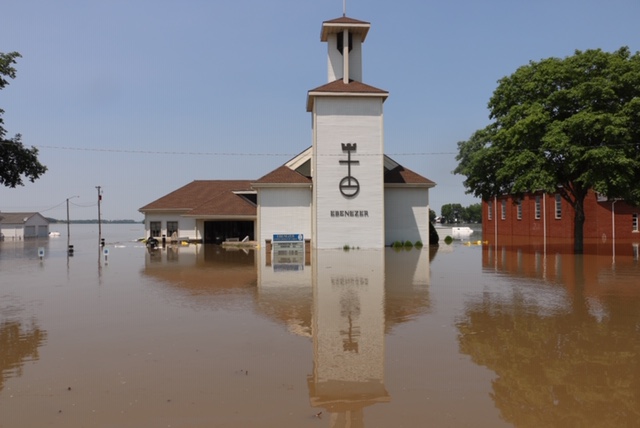
From 1913 to 1918, Carl Schnake served at Die Deutsche Evangelische Ebenezer Gemeinde, or Ebenezer Evangelical Church, in Levasy, Jackson, Missouri, located east of Independence and Kansas City. The church was founded in 1892. Today, it is Levasy Ebenezer United Church of Christ, 206 W Old Lexington Road, Levasy, MO 64066-0000 (816-650-3653) (Rev. Jeanne Dressel Lischer – euccpastor@outlook.com).
parishes in Iowa
From 1918 to 1920, the Eden archives show Carl Schnake at Saint John Evangelical Church in Fremont Township, Butler, Iowa. The 1920 federal census also lists the family in Fremont, Butler, Iowa. Charles Schnake (59) is listed as a “preacher gospel” in a “church.” Also in the household are Anna (50), Emily ? [Emil] (20), Alfred (19), and Reinhardt (10). But Fremont Township includes no incorporated communities. A map from 1895 shows only farms and a cemetery. An Internet search shows that no churches are located in the township today. There are additional Fremont Townships in other Iowa counties, but these two sources specify Butler County. There is an incorporated town in Iowa named Fremont, but it is in Mahaska County, and there are no UCC churches there today. So exactly where St. John’s was and what became of it is unknown.
An entry in the Eden Seminary archives says that Carl Schnake served a church at Nashua, Iowa with no date or specific congregation provided. This also corresponds with his obituary. Nashua is a city in Chickasaw and Floyd counties. This congregation may have been Die Deutsche Evangelische St. Johannes Gemeinde, or St. John’s Evangelical Church founded in 1888. Today, it is Nashua St. John’s United Church of Christ, 10009 Union Street, Nashua, IA 50658-9468 (Rev. Charles L. Dorsey – no email address).
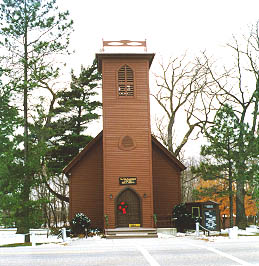
In an utterly non-related but interesting aside, Nashua is also the site of a congregation originally called the Puritan Congregational Church, but now known as “The Little Brown Church in the Vale.” This congregation claims the distinction of being the church referred to in the hymn “The Church in the Wildwood.” In their online history, they state:
[Sometime around 1856] a young music teacher named William Pitts was traveling by stagecoach from Wisconsin to Iowa to visit his future wife. While waiting for the stagecoach horses to be changed, he walked down Cedar Street and saw the empty lot where the church now stands. Being a romantic young man, the thought came to him of what a charming setting the spot would make for a church. Returning home, he wrote the poem “Church in the Wildwood,” and later set it to music. He put it away in a drawer and forgot it.
Meanwhile, church members grew tired of meeting in places such as the lawyer’s office, abandoned stores and parishioners’ homes. They began making plans to build a church. A family in the parish gave them the property . . . By 1862 the building was enclosed . . . When it came time to paint the building, the cheapest paint to be found was Ohio Mineral Paint, which would protect the wood but which was unhappily brown . . . The building was finished, complete with bell, in 1864.
Mr. Pitts had married and was living in Wisconsin. In 1862 the couple moved to Fredericksburg to be near her elderly parents and Mr. Pitts was hired to teach singing class at the Bradford Academy. Imagine his surprise when he saw a little brown church nestled in the very trees where he had stood some years before. He went home and found the song and taught it to his class who sang it at the dedication service of the church. Pitts had written a song for a church that wasn’t there. The congregation had painted their little church brown without ever hearing of the song.
History took another turn when the Weatherwax Quartet traveled throughout Canada and the United States between 1910 and 1921. Their theme song was “The Church in the Wildwood” and they talked about the little church.
It is unlikely that Carl Schnake served this congregation because it came from the English-speaking Congregational tradition rather than the German-speaking Evangelical tradition.
final parishes in Illinois
From 1921 to 1922, Carl Schnake was back in Illinois, serving at Die Deutsche Evangelische St. Paul Gemeinde, or Saint Paul Evangelical Church in Bible Grove, Clay County, Illinois, south of Effingham. Today, there is a St. Paul’s United Church of Christ located about seven miles south of Bible Grove in Louisville, Illinois. It was founded in 1881. The Louisville St. Paul’s United Church of Christ is at 19754 1st Avenue, Louisville, IL 62858-0000 (no pastor listed and no email address).
Finally, from 1923 to 1924, the Schnakes returned to Anna’s home town of Hoyleton, Washington, Illinois where according to the Eden archives he served at her home congregation, Die Deutsche Evangelische Zions Gemeinde, or Zion German Evangelical Congregation. However the history of the Zion congregation in their diamond jubilee booklet (1936) shows that the pastor during that period was Rev. Daniel Bierbaum who served there from 1923 to 1927. It does not list Carl Schnake as a pastor. It is possible that Carl Schnake was in ill health at this time and may have served in some fashion as an associate pastor at Zion under the leadership of Pastor Bierbaum.
death and burial
Rev. Carl Schnake died on July 9, 1924 in Hoyleton, Washington, Illinois at age 64. Anna (Struckmeier) Schnake died on July 13, 1930 also in Hoyleton at age 65. They are both buried in Zion Evangelical Cemetery in Hoyleton.
sons in the ministry
Carl Schnake’s eldest son, Paul Carl Schnake (b. August 16, 1890), and his second youngest son, Alfred Schnake (b. 1901) both became Evangelical ministers and studied at Eden Seminary. The Seminary moved from Wellston to Webster Groves in 1924.